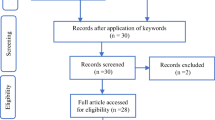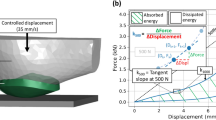Abstract
Summary
A variety of hip protectors are available, but it is not clear which is the most effective and there is no standard test to evaluate their performance. This is the first study that uses a standard mechanical test on hip protectors. Some protectors perform well but others are almost ineffective, providing little to no protection to the wearer during a fall.
Introduction
Each year, over 70,000 patients are admitted to hospital in the UK with hip fractures. There are a variety of commercial hip protectors currently available. However, it is not explicitly clear which is the most effective with regard to maximum force attenuation, whilst still being both comfortable for the user and providing reasonable force reduction if misplaced from the intended position. The numerous test methods reported in the literature have given conflicting results, making objective comparison difficult for users, researchers, and manufacturers alike. The Canadian Standards Association (CSA) has therefore published an express document (EXP-08-17) with a draft standard test method. This paper presents initial results for a range of hip protectors.
Methods
Eighteen commercially available hip protectors were tested according to EXP-08-17. Each hip protector was impacted five times in correct anatomical alignment over the greater trochanter and once at 50 mm displacements in the anterior, posterior, and lateral directions.
Results
Considerable differences were identified between individual hip protectors in their ability to reduce impact forces on the femur (between 3% and 36% reduction in peak force). The performance was reduced when misplaced in many cases (maximum reduction only 20%).
Conclusions
This is the first study that uses a standard mechanical test on hip protectors. Previous studies have used a variety of methods, making it difficult to interpret results. We hope that these results using a standard test method will facilitate the effective comparison of results, as well as providing useful data for clinicians, users, and purchasers.





Similar content being viewed by others
References
Royal College of Physicians (2018) National Hip Fracture Database annual report 2018. RCP, London Available at: http://www.nhfd.co.uk/. Accessed 31 Dec 2018
Nevitt MC, Cummings SR (1993) Type of fall and risk of hip and wrist fractures: the study of osteoporotic fractures. The Study of Osteoporotic Fractures Research Group. J Am Geriatr Soc 41:1226–1234
Kannus P, Leiponen P, Parkkari J, Palvanen M, Jarvinen M (2006) A sideways fall and hip fracture. Bone 39:383–384
Parkkari J, Kannus P, Palvanen M, Natri A, Vainio J, Aho H, Vuori I, Jarvinen M (1999) Majority of hip fractures occur as a result of a fall and impact on the greater trochanter of the femur: a prospective controlled hip fracture study with 206 consecutive patients. Calcif Tissue Int 65:183–187
Kanis JA, Johnell O, Oden A, Jonsson B, De Laet C, Dawson A (2000) Risk of hip fracture according to the World Health Organization criteria for osteopenia and osteoporosis. Bone 27:585–590
Hernlund E, Svedbom A, Ivergard M, Compston J, Cooper C, Stenmark J, McCloskey EV, Jonsson B, Kanis JA (2013) Osteoporosis in the European Union: medical management, epidemiology and economic burden. A report prepared in collaboration with the International Osteoporosis Foundation (IOF) and the European Federation of Pharmaceutical Industry Associations (EFPIA). Arch Osteoporos 8:136
Johnell O, Kanis JA (2006) An estimate of the worldwide prevalence and disability associated with osteoporotic fractures. Osteoporos Int 17:1726–1733
Jordan KM, Cooper C (2002) Epidemiology of osteoporosis. Best Pract Res Clin Rheumatol 16:795–806
NICE (2016) National Institute for Health and Care Excellence. Hip fracture for adults NICE quality standard. https://www.nice.org.uk/guidance/qs16/documents/draft-quality-standard-2. Accessed 8 Oct 2018
Baker PN, Salar O, Ollivere BJ, Forward DP, Weerasuriya N, Moppett IK, Moran CG (2014) Evolution of the hip fracture population: time to consider the future? A retrospective observational analysis. BMJ Open 4:e004405
White SM, Griffiths R (2011) Projected incidence of proximal femoral fracture in England: a report from the NHS Hip Fracture Anaesthesia Network (HIPFAN). Injury 42:1230–1233
Holt G, Smith R, Duncan K, Hutchison JD, Reid D (2009) Changes in population demographics and the future incidence of hip fracture. Injury 40:722–726
Parker MJ, Gillespie WJ, Gillespie LD (2006) Effectiveness of hip protectors for preventing hip fractures in elderly people: systematic review. BMJ 332:571–574
Santesso N, Carrasco-Labra A, Brignardello-Petersen R (2014) Hip protectors for preventing hip fractures in older people. Cochrane Database Syst Rev:CD001255
Derler S, Spierings AB, Schmitt KU (2005) Anatomical hip model for the mechanical testing of hip protectors. Med Eng Phys 27:475–485
Minns J, Dodd C, Gardner R, Bamford J, Nabhani F (2004) Assessing the safety and effectiveness of hip protectors. Nurs Stand 18:33–38
Choi WJ, Hoffer JA, Robinovitch SN (2010) The effect of positioning on the biomechanical performance of soft shell hip protectors. J Biomech 43:818–825
Kannus P, Parkkari J, Poutala J (1999) Comparison of force attenuation properties of four different hip protectors under simulated falling conditions in the elderly: an in vitro biomechanical study. Bone 25:229–235
van Schoor NM, van der Veen AJ, Schaap LA, Smit TH, Lips P (2006) Biomechanical comparison of hard and soft hip protectors, and the influence of soft tissue. Bone 39:401–407
Laing AC, Feldman F, Jalili M, Tsai CM, Robinovitch SN (2011) The effects of pad geometry and material properties on the biomechanical effectiveness of 26 commercially available hip protectors. J Biomech 44:2627–2635
Laing AC, Robinovitch SN (2008) The force attenuation provided by hip protectors depends on impact velocity, pelvic size, and soft tissue stiffness. J Biomech Eng 130:061005
Laing AC, Robinovitch SN (2008) Effect of soft shell hip protectors on pressure distribution to the hip during sideways falls. Osteoporos Int 19:1067–1075
Parkkari J, Kannus P, Poutala J, Vuori I (1994) Force attenuation properties of various trochanteric padding materials under typical falling conditions of the elderly. J Bone Miner Res 9:1391–1396
Li N, Tsushima E, Tsushima H (2013) Comparison of impact force attenuation by various combinations of hip protector and flooring material using a simplified fall-impact simulation device. J Biomech 46:1140–1146
Wiener SL, Andersson GBJ, Nyhus LM, Czech J (2002) Force reduction by an external hip protector on the human hip after falls. Clin Orthop Relat Res (1976–2007) 398:157–168
Mills NJ (1996) The biomechanics of hip protectors. Proc Inst Mech Eng H J Eng Med 210:259–266
Robinovitch SN, Evans SL, Minns J, Laing AC, Kannus P, Cripton PA, Derler S, Birge SJ, Plant D, Cameron ID, Kiel DP, Howland J, Khan K, Lauritzen JB (2009) Hip protectors: recommendations for biomechanical testing—an international consensus statement (part I). Osteoporos Int 20:1977–1988
Cameron ID, Robinovitch S, Birge S, Kannus P, Khan K, Lauritzen J, Howland J, Evans S, Minns J, Laing A, Cripton P, Derler S, Plant D, Kiel DP (2010) Hip protectors: recommendations for conducting clinical trials—an international consensus statement (part II). Osteoporos Int 21:1–10
CSA (2017) Hip protectors—express document. CSA Group. http://shop.csa.ca/en/canada/injury-prevention/exp08-17/invt/express082017 EXP-08-17. Accessed 15 May 2017
Robinovitch SN, Hayes WC, McMahon TA (1991) Prediction of femoral impact forces in falls on the hip. J Biomech Eng 113:366–374
European Committee for Standardization. EN 1621-1:1997 Motorcyclists’ protective clothing against mechanical impact. Part 1: requirements and test methods for impact protectors
Motorcycle Industry Association. Statistics. http://www.mcia.co.uk/page/rider-license-holders. Accessed 1 Jan 2019
Author information
Authors and Affiliations
Corresponding author
Ethics declarations
Conflicts of interest
Sam Evans was a consultant to the Ascent Group on hip protector design and testing and Dow Corning on impact protection materials and testing. Both Sam Evans and Bethany Keenan are consultants for Delloch and SpineCor. Delloch provided the majority of the hip protectors for this study.
Additional information
Publisher’s note
Springer Nature remains neutral with regard to jurisdictional claims in published maps and institutional affiliations.
Rights and permissions
About this article
Cite this article
Keenan, B.E., Evans, S.L. Biomechanical testing of hip protectors following the Canadian Standards Association express document. Osteoporos Int 30, 1205–1214 (2019). https://doi.org/10.1007/s00198-019-04914-x
Received:
Accepted:
Published:
Issue Date:
DOI: https://doi.org/10.1007/s00198-019-04914-x




